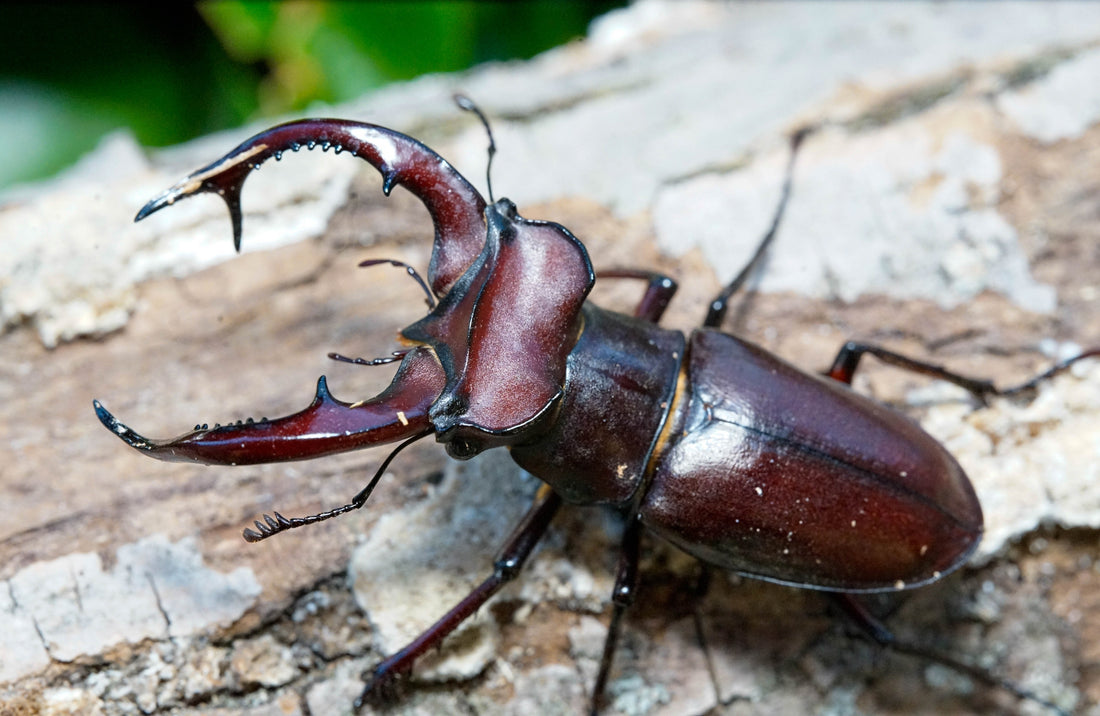
Giant stag beetle caresheet
Share
Adults:
- Size: 30-66mm
- Adult life span once active: 2-5 months
- Dormant/Hibernation period: 6-8 months
- Temperature: 68-75°F if active. 37-55°F if hibernating.
- Humidity: 40-60%
- Food: Beetle jelly or fruits(no citrus)
Hibernation:
- Cold-temperature hibernation is very important for captive-bred adults. Inadequate hibernation can lead to shortened lifespans and hinder their ability to reach sexual maturity.
- Prior to initiating the hibernation process for your adult beetles, ensure that they have been emerged for at least 45 days. Freshly emerged adults are fragile, so exposing them to cold temperatures too rapidly may be detrimental to their well-being.
- One of the best ways to hibernate your adult beetles is to get a wine cooler and set the temperature to around 45-55°F. This is the optimal temperature range for hibernation.
- Another way is to put them in your refrigerator; however the temperature inside the refrigerator must NOT go below 37°F.
- During this hibernation process, you must keep the beetle moist at all times. It's easy for the beetles to dry out, especially when kept in the refrigerator.
- After maintaining your beetles in cold temperatures for approximately 4-5 months, try to gradually raise the temperature if possible. With a wine cooler, this is easy to do. However, if a refrigerator was used, transitioning the beetles to a cool basement or outdoor setting in early spring when temperatures remain cool(55-60°F) is recommended. After approximately 2-4 weeks in these conditions, you can then transition them to a room-temperature environment.
- The hibernated beetles should become active in a few days to weeks once they are kept in room temperature. Make sure to keep a close eye on them as they can choose to become active at any time.
- Mating is possible about 2 weeks after they start feeding.
Breeding:
- Required temperature for breeding: 68-75°F
- Minimum container size for egg laying: 6in x 5in x 6in
- # of eggs laid on average: 10-40 eggs
- Flake soil humidity adjustment: The amount of water is appropriate when you can form a ball by squeezing the flake soil with your hand. Water seeping out of your hands during the process indicates that there is too much water.
- Set-up: Tightly press down about three to four inches of flake soil with your hands and then loosely fill the container with flake soil. Afterwards, you can put the female in the container with some sticks and jelly so that she can flip herself over if needed.
Set-up example:

Larvae:
- Food:
- Flake soil
- decayed white-rotten wood
- Temperature: 70-75°F
- Humidity: 60%
- Larval duration: 1-2 years
- Container size recommendations:
- L1-L2: 4oz deli cup
- L3: 16-32oz deli cup
- Larval behavior: If larvae are kept together in a big container, they will often stridulate to communicate with each other.
- Pupation: Late L3 larvae will sometimes come up to the surface in search for a place to pupate. Placing clay at the bottom of the container can stop their wandering and prompt them to construct their pupal cells within the clay layer. Once they make their pupal cell, it may take a few weeks to a few months before they pupate. While the reason for the long prepupal period remains unclear, it has been observed that higher temperatures, specifically 80°F and above, appear to trigger pupation. However, further testing is required to confirm this is true.
Helpful notes and tips:
- If kept in room temperature, larvae should become adults in about a year; however, some larvae will take 2 years to become adults since they can take a few months to pupate. I've had a larva sit in their pupal cell for 7 months!
- Larvae can be kept together without any issues.